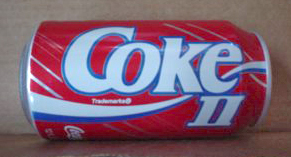New Coke facts for kids
New Coke was a special version of Coca-Cola that was sold for a short time, mainly from 1985 to 1992. It tasted sweeter than the regular Coca-Cola. Later, it was even called Coke II. New Coke is famous for being one of the biggest marketing mistakes in history, even though the company had good reasons for trying something new.
Contents
Why Did Coca-Cola Change Its Recipe?
In the early 1980s, Coca-Cola was the most popular soft drink in the world. However, a big competitor, Pepsi, was gaining ground. Pepsi had started a marketing campaign called the "Pepsi Challenge." In this challenge, people tasted Pepsi and Coke without knowing which was which. Many people chose Pepsi because they found its taste sweeter and more appealing in a quick sip.
Coca-Cola's leaders became worried. They saw their market share (the amount of sales they had compared to competitors) slowly shrinking. They thought the problem might be the taste of their drink. So, they decided to create a new, sweeter formula that they hoped would win back customers and beat Pepsi in taste tests.
Developing the New Taste
Coca-Cola spent a lot of time and money developing the new recipe. They tested it with thousands of people across the United States. These taste tests were done "blind," meaning people didn't know if they were drinking the old Coke, the new Coke, or Pepsi. The results seemed clear: most people preferred the new, sweeter formula over both the original Coke and Pepsi.
Based on these positive test results, Coca-Cola felt confident. They believed they had found a winning recipe that would help them stay number one in the soda market.
The Big Announcement in 1985
On April 23, 1985, Coca-Cola made a huge announcement. They told the world they were changing the secret formula of Coca-Cola for the first time in 99 years! The new drink, simply called "Coke," would replace the original. This news shocked many people.
The company stopped making the old Coke and started selling the new version. They spent a lot of money on advertising campaigns to promote the new taste. They hoped everyone would love it as much as the taste testers did.
What Happened Next?
Instead of celebrating, Coca-Cola faced a huge backlash. Many loyal Coca-Cola drinkers were very upset. They loved the original taste and felt betrayed by the company. People started calling the new drink "New Coke" to tell it apart from the old one, and the name stuck.
- Customers called Coca-Cola's offices to complain.
- They wrote angry letters.
- Some even started protest groups, like "Old Cola Drinkers of America," demanding the return of the original Coke.
- People hoarded cases of the old Coke that were still available in stores.
The protests were so strong that Coca-Cola's phone lines were jammed with calls. The company realized they had made a big mistake. While the taste tests showed people liked the new flavor, they had not considered how much people loved the idea and history of the original Coca-Cola. It wasn't just a drink; it was a part of American culture.
Bringing Back the Original
After just 79 days, Coca-Cola announced that they would bring back the original formula. On July 11, 1985, the company brought back the old drink, calling it "Coca-Cola Classic." This news made many people very happy.
The return of Coca-Cola Classic was a huge success. Sales of the original drink soared, and many people felt a renewed loyalty to the brand. Some people even wondered if the whole "New Coke" event was a clever marketing trick to make people appreciate the original more, but Coca-Cola always said it was a genuine mistake.
The End of New Coke
New Coke continued to be sold alongside Coca-Cola Classic for a few years. It was later renamed "Coke II" in 1992. However, it never became popular and was slowly phased out of most markets. By 2002, Coke II was officially discontinued in the United States.
The story of New Coke is often taught in business schools as an example of how important it is to understand your customers, not just their taste preferences, but also their emotional connection to a product.
Images for kids
See also
 In Spanish: New Coke para niños
In Spanish: New Coke para niños



